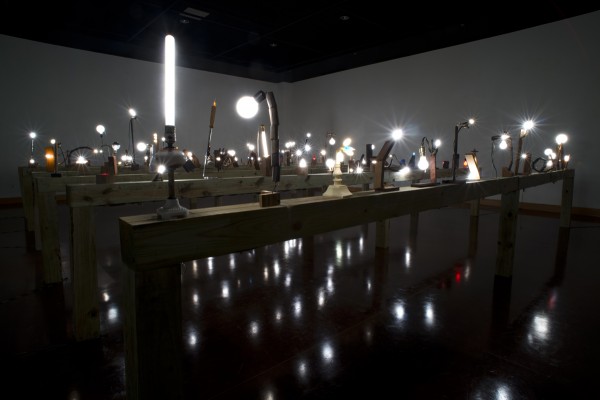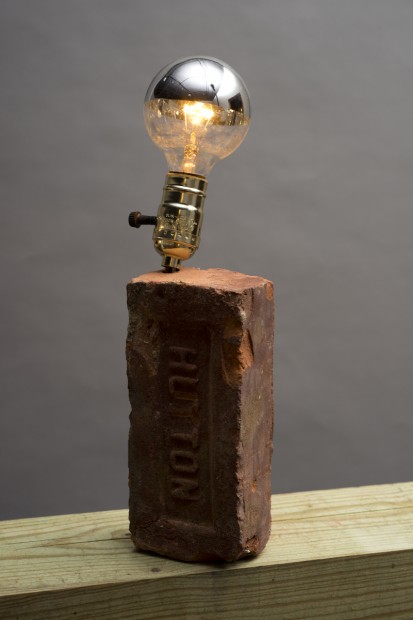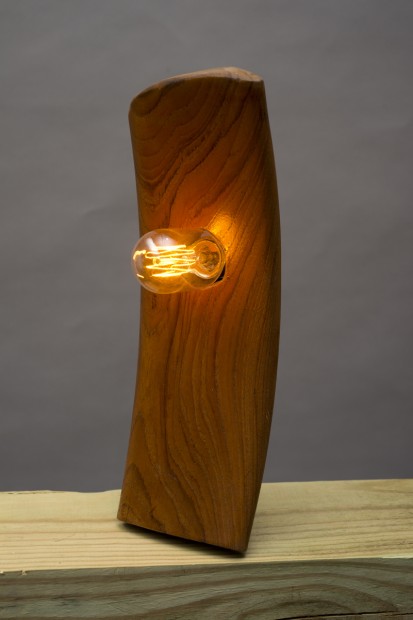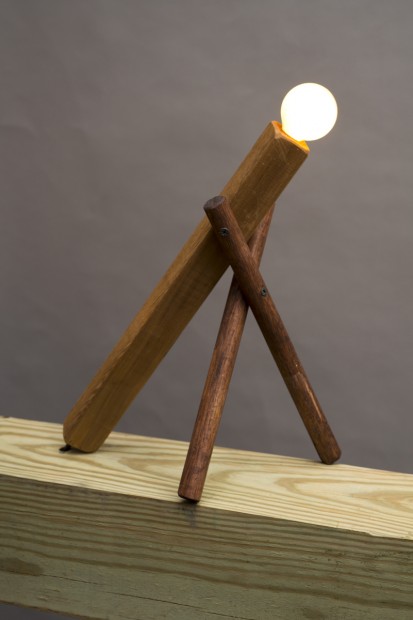Colby Bird is an artist born and raised in Austin, now living in Brooklyn, New York. He often blends the discourses of photography and sculpture, and is currently exhibiting 100 handmade house lamps at the Texas State Galleries in San Marcos. I met up with him to discuss the comfort of a studio practice, craft and photographs as objects.
Katie Geha: Can you tell me a little about the exhibition? Why make 100 electric lamps?
Colby Bird: This spring I was diagnosed with Ménière’s disease. It’s a ringing in my inner ear that can cause spells of vertigo. I’ve fallen over before, or sometimes it’s hard to walk in a straight line. It was really bad when I started making these and it hit me that the disease might be something I have to deal with for the rest of my of life, so I thought, “I have to adjust to this.” My way of adjusting to it was that on the weekends I didn’t want to go to bars or openings or the movies, so I went to my studio. In my studio I was in control of my surroundings and I could lie down if I wanted to. It was just really comforting to have a place to go and have these materials to work with.
KG: What was it about the lamps that was comforting? Or how did the process of making get started?
CB: I had a show at Fitzroy Gallery in New York and my studio was kind of empty, and I had just moved into a new apartment. I started making lamps for my new home and I just kept making them and they started stacking up in my apartment. It started to look crazy, like I was an insane person. So I moved them to my studio and then just kept making them and making them, and it eventually became a really comforting activity. It was kind of like being a painter, or that’s how I saw it. I’ve always had this kind of jealousy of painting and the way it’s the symbol of art and it’s a trade that everyone accepts.
KG: So it seems like the lamps are linked closely to a studio practice.
CB: Right. It was nice to come to my studio to have something to do that was set. I could always go there and make something happen. It was not like photography or sculpture. Certainly there was a lot of searching around for materials, but it was a lot more casual.
KG: Was it more casual because you were making a utilitarian object?
CB: Yeah, well it was casual because there was no history or future for any piece. It grew really organically.
KG: And fairly quickly since the Fitzroy show was last spring?
CB: Yes, I was able to give myself a schedule. I told myself I would make five a week and calculated the time from then until now. I took to it pretty well. A part of this show is just doing something to the best of your abilities. Like if the store I needed to get materials from was closed or I didn’t have the proper materials or if a drill bit was broken, I just had to make it work. I really pictured a dad in the garage, making his wife a lamp or making his kids a crappy present, something that he cobbled together and how charming that really is.
KG: The process was different than painting or sculpture because there was an end goal? It had to light up?
CB: When I do sculpture and photography, I set way more parameters of what I envision the end product will look like. Before I start, for the sculptures I am working with a specific type of Czechoslovakian chair. So I have to go find them, or get them on eBay, and it’s very specific. I envision the kind of organic, sexual, figurative form. Whereas with the lamps, I would just have a pile of stuff on my floor and I had to make five out of what was there, regardless. Or I’m walking to the studio and I find a brick and so I think “okay, that will be a lamp.” And I have to get through the brick with whatever crappy drill bit I have at the time. It was a lot of weird challenges like that. Not just within my studio but also within the cities of New York and Brooklyn.
KG: Why make so many of them?
CB: 100 just seemed like a good square number. It was a solid achievement number. That’s all 100 is, really. And I didn’t think I would have the patience to make that many. So it was also a challenge. It felt like I achieved something.
KG: You weren’t thinking about the installation? How an accumulation of lit lamps would look really beautiful?
CB: Right, the number came first. I wasn’t thinking about the installation.
KG: In the Fitzroy show there is an undercurrent of a craft tradition—with the knobs, and hooks, and wooden sculptures. Did some of the lamps come out of that show? Pushing the work into a craft realm?
CB: Yes, in the Fitzroy show there were the very refined photographs upstairs with these professionally made, really gorgeous frames made by these guys named Phrame in Baltimore. The photographs were professionally printed and mounted and framed. The photos were very hands-off stuff. Then I bought these very expensive golden brass fixtures and did this one small gesture of very tentatively affixing those things to the beautiful frames. That was the only hand-done gesture upstairs. Except for the clever placement, there was a little intrusion on each beautiful object.
Downstairs was more or less a shop, which is where the lamps grew out of. The wood sculptures, which are balanced on pieces of fruit, were in that space. I imagined it as Dad’s basement, where he’s doing the best he can to make these objects.
KG: Your installations often feature an element of change. For instance, at your most recent show at Lora Reynolds, with the help of the gallery attendant, the viewer could rearrange objects in the space. Or in this installation, the gallery attendant will have to replace bulbs. Why make it interactive, to a degree?
CB: There is an element of wanting the work to continue beyond my studio. So at Lora Reynolds the photographs were exchanged or the fruit dies and the sculpture moves. I want that physicality to exist—the creation of it and the exhibition of it, to continue to extend its life.
KG: This makes sense in relation to the work at Fitzroy that’s hung crooked or is on hooks. The idea that they could be arranged in a multitude of ways, or that there is always a sense of contingency.
CB: Exactly, the hope is that each time it’s installed, it’s slightly different. The installation can never be perfectly replicated.
KG: The frames and the hooks and knobs also work to constantly push me out of the frame. I can’t be immersed in the illusion of the photograph.
CB: Right, it’s not trying to trick you. Instead, it shows you what a photograph is—here is the front, here is the back. Someone made this frame.
KG: You’re asserting the photograph as an object?
CB: Yes. I’ve been thinking about photographs as objects and not windows. Though, in the Fitzroy show many of the photographs were windows—travel photographs, me lugging my 4 x 5 and taking a photo of a beautiful vista in Dubrovnik. I’m doing a project for Miami Basel where I am going to show photographs that I didn’t take, 1970s professional photographs that I just found. It will be a whole different level of mediation—essentially found objects that I’ve chosen to frame.
KG: Right, that kind of happens in your photograph of Kiera Knightley. Sure, it’s an image of a celebrity, but it seems to be just as much an image about the object of the photograph. There is this tension between flatness and illusion in a lot of your photographs. I’d also say there is a strong attention to light.
CB: Right, the lighting can give attention to the construction of the work. If there is some awkward lighting where you can’t figure out how the interior light is matching the exterior light, and your brain is forced to consider the construction of the photograph.
I picture these kind of planes. There is the person, the plane between the person and the photograph, the glass between the photograph, the photograph and the content, and then there’s behind the photograph, the walls. I think some of my favorite photographs just have more and more stacked up layers.
The image on the card for this exhibition is a good example. It’s an image of a painting of me when I was a kid, but you can see the flash from my crappy camera reflecting off the frame of the painting. And, especially now that it’s on a card, it’s even weirder. There are so many levels of back and forth.
KG: I saw your show at Okay Mountain in 2009 and then also your show at Lora Reynolds last year…it seems that your work has gotten more formal? Maybe more serious? Or at least less mired in what I often think of as “boy art.”
CB: Yes, I hope so!
KG: Is that a conscious effort or just becoming more mature in your work?
CB: Both. I work in sculpture and photography because I want to present objects that are readily identifiable and relatable. But it can get really dangerous. And it gets really dangerous when you use a celebrity’s face because you’re using it for just some kind of symbol for desire, but it’s instantly identified as something else. I mean…I’m hesitant to even use any celebrity names or popular culture references because it just goes off in this whole other direction that you can’t control.
KG: Were you interested in not being able to control it? That by using popular culture it might allow the work to be more open or relate more to the viewer?
CB: No, not really. I was more interested in people looking at an artist desiring those things. Watching that desire happen. I wasn’t interested in the political ramifications of me and Keeley Hazell or some pin-up girl. I was more interested in the social relevance of that desire and when that desire exists and doesn’t, or when the artist feels comfortable communicating that desire.
KG: So…sexual desire because she’s a pin-up?
CB: I want the audience to consider if I was in a mental space where I would actually have posters of Keeley Hazell around, you know… it was supposed to bring someone into my way of thinking or general social economic…I don’t know how to put this, really! I’m dancing around saying “Tupac” because even though we are talking about NOT making work with Tupac, folks will read this and only come away with that name or image. Ha, so I’ve basically screwed myself by even letting that name be spoken.
KG: I mean, I think I know what you’re saying. You’re talking about cultural shortcuts. You can identify it and see it and place it very quickly.
CB: Yes, so you can say if you have a poster of Tupac in the corner of your show, you’re immediately making a connection with a specific history and a specific audience.
KG: For me though, sometimes a poster of Tupac means I don’t have to do as much work as a viewer. Whereas, say your work at Fitzroy makes me think a little harder, try more to create connections and meaning.
CB: I think no longer making work like that means that I am more confident with myself and more confident with the viewer.
KG: And more confident with the material. Being more straightforward with the photograph. I mean it’s not like writing “swagger” on a banner as you do in your early work.
CB: I’m not sure it is demanding less or more, because a big banner that says “swagger” can be so instantly funny and interesting. But there it is again—we are talking about a great old body of work that, because of its pop cultural relevance, will overwhelm this interview. But I still love talking about it because it’s utterly honest work. A friend of mine once said that you will never make as bad or as honest work as your first solo show in New York. That’s absolutely true.
KG: It can also be a pretty pointed critique.
CB: Right, it can be difficult. What I noticed was that where it was displayed at different spots sort of reflected my confidence level at the time. It went from small to big. Eventually, it made it to a permanent site, hanging in my high school gym. The colors of the banner are my high school colors and “swagger” is adopted from a fetishization of black culture. And the whole crucible of that was born out of my high school experience, so it makes complete sense to me that it should reside in that very gym.
KG: And say you were to put that same banner up at Miami Basel, it would mean something entirely different.
CB: And that would be my worst nightmare.
KG: So you want to be sincere about it?
CB: Yes, absolutely.
KG: It makes sense that it’s in your high school. I don’t think it could be more of a sincere or sentimental site.
CB: I know. I damn near cried when I gave it to my high school band teacher.
Colby Bird: House Lamps
Texas State University, University Gallery
September 24 – October 18, 2012
____________
Katie Geha is a writer, curator and art historian living in Austin, Texas. She grew up in Ames, Iowa and received her MA in art history from the School of the Art Institute of Chicago and her PhD in art history from the University of Texas, Austin.







